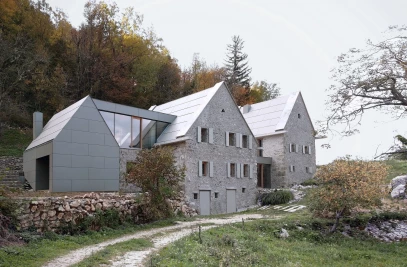Večna pot, which means “eternal way” in the Slovenian language, is the name of one of the longest streets in Ljubljana. It connects two distant districts of the city, most of it running through an ancient forest on the slopes of the hills that now form part of Tivoli Park. According to some historical sources, the road is said to have existed in prehistoric times when the Ljubljana basin was still a lake and the pile dwellings culture flourished on the slopespast which Večna potnow runs.
The villa was built on what was once the shore of a lake that dried up in prehistoric times. Thearea was at risk of flooding until recentlywhen regulation systems were built. The pre-regulationeraled to the evolution of a building typology of houses with a raised ground floor. Basements were semi-underground which reduced the danger of flood damage. Access to the ground floor where the main living space was located developed into a unique architectural element: the portico.


The villa is positioned on the corner of two streets and this specificlocation determined its internal organization and the design of its façades and its two entrances. A monumental portico leading to the elevated ground floor, which emphasizes and formalizes the ritual of entering the villa, is set in the corner. The portico’s purpose is to make both an imposing accent and to provide a covered way to the front door. This more formal entrance leads to a foyer and a grand living area. The second entrance to the villa is at street level and is designed for the daily use of the family.


In addition to the grand living room, which is connected to the first floor via a double-height void, the ground floor also has a service area, kitchen, and dining and family room. A rectangular staircase connects all three floors. The upper floor accommodates the sleeping quarters. The double-height space in the house creates a dynamic interplay betweenthe ambiences.
The façade of the villa is designed in black brick. Here, too, a link to the house’s specific location can be found. The soil in the area of the former lake is black peat, and this blackness is also characteristic of the Ljubljana marshes. Moreover, the use of black bricks served to dematerialize the volume of the house and to provide a contrast with the greenery around the house.


Structurally, the south-west corner cantilevers over the ground floor. A large panoramic glass window is inserted in this part of the house providing a view onto the marsh at the portico entrance.
The Večna pot Villa paraphrases a number of eternal architectural themes. First, there is portico entrance described above. Second, the corner location is a classic theme. Inside the house, there is the tripartite character of the volume, an almost obligatory part of architecture until modernism, which is also clearly manifested on the façade of the villa. The overall form skillfully plays with these themes, intertwining and integrating them into the urban fabric.


Team:
Architect: OFIS arhitekti
Project team: Rok Oman, Spela Videcnik, Andrej Gregoric, Janez Martincic, Matej Krajnc, Laura Martinez Vega, Ewa Tomczyk, Agnese Nascimben, Justyna Chowaniec
Structural engineering: Project PA d.o.o
Mechanical engineering: STROJNIK s.p.
Electrical engineering: Elektrobiro s.p.
Interior design: Saša Šekoranja, Nives Ajdovec
Photography: Tomaz Gregoric

























































